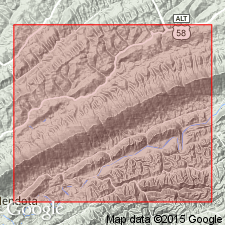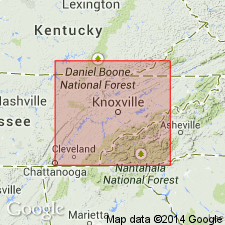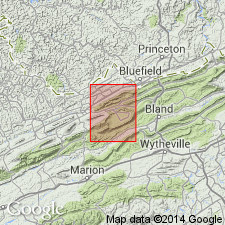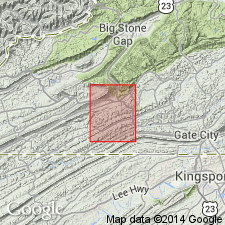
- Usage in publication:
-
- Big Stone Gap shale*
- Modifications:
-
- Original reference
- AAPG geologic province:
-
- Appalachian basin
Summary:
Big Stone Gap shale. Black shale, generally soft, but contains some beds of harder, platy, dry, dull-black argillite. Thickness 320+/- feet. Has same lithologic character as Chattanooga shale at Chattanooga. Ulrich identifies fossils from upper 100 feet as of Sunbury age and those from lower part as of Cleveland and Huron age. Was not found in any section where Chemung rocks are recognized and relation to Chemung is therefore not positively established. Rests on Portage shale and underlies Price sandstone.
Named from Big Stone Gap, southwestern VA.
See also Wilmarth, M.G., compiler, 1929, Tentative correlation of the named geologic units of Virginia, USGS unpub. Corr. Chart, Apr., 1929, sheet 2 of 2.
[GNC remark (ca. 1936, US geologic names lexicon, USGS Bull. 896, p. 187): The USGS at present adheres to original definition of Big Stone Gap shale. Age is considered Late Devonian and Early Mississippian. Recognized in southwestern VA.]
Source: US geologic names lexicon (USGS Bull. 896, p. 187).

- Usage in publication:
-
- Big Stone Gap shale
- Modifications:
-
- Age modified
- AAPG geologic province:
-
- Appalachian basin
Summary:
Big Stone Gap shale contains typical Chemung fossils and is definitely Devonian.
Source: US geologic names lexicon (USGS Bull. 896, p. 187).

- Usage in publication:
-
- Big Stone Gap shale
- Modifications:
-
- Not used
- AAPG geologic province:
-
- Appalachian basin
Summary:
Pg. 498. Big Stone Gap shale. The evidence to be presented later indicates a Mississippian age for upper part and a Devonian age for lower part of Big Stone Gap shale of Stose and Ulrich. The name Big Stone Gap is here restricted to uppermost part. (See Big Stone Gap member.)
See also Wilmarth, M.G., compiler, 1929, Tentative correlation of the named geologic units of Virginia, USGS unpub. Corr. Chart, Apr., 1929, sheet 2 of 2.
[GNC remark (ca. 1936, US geologic names lexicon, USGS Bull. 896, p. 187): The USGS at present adheres to original definition of Big Stone Gap shale. Age is considered Late Devonian and Early Mississippian. Recognized in southwestern VA.]
Source: US geologic names lexicon (USGS Bull. 896, p. 187).

- Usage in publication:
-
- Big Stone Gap shale*
- Modifications:
-
- Areal extent
- AAPG geologic province:
-
- Appalachian basin
Summary:
Pg. 143-144, pl. 15. Stose (1923) named Big Stone Gap shale from Big Stone Gap, Virginia. Swartz (1926) [1927]) proposed that Big Stone Gap be used as name for upper member of Chattanooga formation. Present writer [Cooper] agrees with Swartz's restriction of name but doubts advisability of designating the shale as a member. Geographic distribution of unit is sufficiently extensive for shale to be regarded as formation. In Burkes Garden quadrangle [this report], Big Stone Gap shale is present only in belt immediately north of St. Clair fault. Where well exposed near south edge of Bluefield, formation consists of about 10 feet of black fissile shale. This shale was identified as Sunbury shale by Reger (1926, West Virginia Geol. Survey Rpt. Mercer, Monroe and Summers Counties), but this correlation has scant supporting evidence. Writer traced black shale zone at base of the Price from Bluefield, Virginia, southwestward to Duffield, Scott County and is satisfied that the black shale at Bluefield is upper part of Big Stone Gap shale of Stose and the Big Stone Gap member of Chattanooga formation of Swartz. Underlies Price formation; overlies "Chemung." Age is Mississippian (Kinderhook).
Source: US geologic names lexicon (USGS Bull. 1200, p. 341-342).

- Usage in publication:
-
- Big Stone Gap siltstone*
- Modifications:
-
- Redescribed
- AAPG geologic province:
-
- Appalachian basin
Summary:
Described in Duffield quadrangle as Big Stone Gap siltstone. This formation was defined as shale by Stose. Consists of about 200 feet of dark-gray to grayish-black carbonaceous siltstone with some interbeds of dark-gray carbonaceous shale. Overlies a 400-foot sequence of siltstone (Portage shale as used by Stose, 1923); underlies Price siltstone. On basis of conodonts collected in Duffield quadrangle and near Big Stone Gap, Hass believed formation to be Late Devonian and Early Mississippian in age.
Source: US geologic names lexicon (USGS Bull. 1200, p. 341-342).
For more information, please contact Nancy Stamm, Geologic Names Committee Secretary.
Asterisk (*) indicates published by U.S. Geological Survey authors.
"No current usage" (†) implies that a name has been abandoned or has fallen into disuse. Former usage and, if known, replacement name given in parentheses ( ).
Slash (/) indicates name conflicts with nomenclatural guidelines (CSN, 1933; ACSN, 1961, 1970; NACSN, 1983, 2005, 2021). May be explained within brackets ([ ]).

